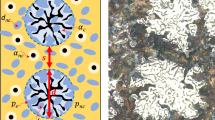Abstract
The tensile strengths of liquid sodium, lead and bismuth, possible coolant materials for generation-IV nuclear reactors, at 0 K (i.e., ideal tensile strength), 293 K, normal melting point and normal boiling point are determined based on generalized van der Waals equations of state. The parameters of the generalized van der Waals equations of state have been determined though the vapor–liquid critical-point parameters. The tensile strengths of liquid sodium, lead and bismuth at 0 K are found to be about 2.65 GPa, 4.67 GPa and 4.33 GPa, respectively. The tensile strengths of liquid sodium, lead and bismuth at 293 K are found to be about 1.33 GPa, 2.98 GPa and 2.62 GPa, respectively. The tensile strengths of liquid sodium, lead and bismuth at normal melting point are found to be about 1.20 GPa, 2.34 GPa and 2.36 GPa, respectively. The tensile strengths of liquid sodium, lead and bismuth at normal boiling point are found to be about 0.43 GPa, 0.90 GPa and 0.62 GPa, respectively. The tensile strengths of liquid lead at 0 K and 293 K, obtained in this work, satisfactorily agree with the literature data. Moreover, spinodal-pressure correlations for sodium, lead and bismuth have been formulated. These correlations are characterized by the correlation coefficient of about 0.9999 and the coefficient of determination of about 0.9999.




Similar content being viewed by others
References
Department of Energy–DOE, A Technology Roadmap for Generation IV Nuclear Energy Systems, Technical Report GIF-002–00, USDOE Nuclear Energy Research Advisory Committee and the Generation IV International Forum: USA, Washington (2002), https://doi.org/10.2172/859029.
M. Takahashi, S. Uchida, Y. Yamada, and K. Koyama, Prog. Nuc. Energ. https://doi.org/10.1016/j.pnucene.2007.11.082 (2008).
J.-Y. Lim and M.-H. Kim, Prog. Nuc. Energ. https://doi.org/10.1016/j.pnucene.2006.12.004 (2007).
B. Yoo, Y-I. Kim, and Y-J. Kim, Transactions of the Korean Nuclear Society Spring Meeting Chuncheon, Korea, May 25–26 (2006).
Y. Tian, W. Tian, D. Zhang, G. Su, and S. Qiu, Proceeding series: Inter. Confer. Nuc. Eng. (ICONE22–30318). (2014). https://doi.org/10.1115/ICONE22-30318.
V. Sobolev, J. Nuc. Mat. https://doi.org/10.1016/j.jnucmat.2007.01.144 (2007).
G.P. Bogoslovskaya. P.L. Kirillov, J. Kupiz, G. Heusener, Y. Nishi, A. Rineikii, A. Stangulesku, D. Wade, and V.V. Yarovitsin, IAEA TECDOC9 1289, Vienna. (2002). Available at: https://www-pub.iaea.org/MTCD/Publications/PDF/te_1289_prn.pdf
I.A. Chusov, V.G. Pronyayev, G.Y. Novikov, and N.A. Obysov, Nuc. Ener. Technol. https://doi.org/10.3897/nucet.6.55232 (2020).
I.A. Chusov, V.G. Pronyayev, G.Y. Novikov, and N.A. Obysov, Izvestiya vuzov. Yadernaya Energetika. (2020). https://doi.org/10.26583/npe.2020.1.11, Available at: https://nuclear-power-engineering.ru/en/article/2020/01/11/.
L.P. Kirillov, Thermophysical Properties of Materials for Nuclear Engineering: A Tutorial and Collection of Data, IAEA, Vienna. Available at: https://www-pub.iaea.org/mtcd/publications/pdf/iaea-thph_web.pdf. (2008).
V. Sobolev, Database of Thermophysical Properties of Liquid Metal Coolants for GEN-IV. Sodium, Lead, Lead-Bismuth Eutectic, Scientific Report of the Belgian Nuclear Research Centre, SCK•CEN-BLG-1069, November 2010 (rev. Dec. 2011).
P. Sabharwall, E.S. Kim, M. McKellar, and N. Anderson, INL/EXT-11–21584 TRN: US1200189, USA: National Park. (2011). https://doi.org/10.2172/1031671.
M. Jeltsov, W. Villanueva, and P. Kudinov, Nuc. Eng. Design. https://doi.org/10.1016/j.nucengdes.2018.01.006 (2018).
C. Wang, S. Wei, W. Tian, S. Qiu, and G.H. Su, Annals Nuc. Energ. https://doi.org/10.1016/j.anucene.2019.06.019 (2019).
V.P. Skripov, Phys. Today. https://doi.org/10.1063/1.3069013 (1975).
L.P. Filippov, Estimation of Thermophysical Properties of Liquids and Gases (Energoatomizdat, Moscow, 1988), p55.
F. Hensel and H. Uchtmaan, Annu. Rev. Phys. Chem. https://doi.org/10.1146/annurev.pc.40.100189.000425 (1989).
P.A. Tamanga, D. Lissouck, F. Lontisi, and M. Tchoffo, African. J. Sci. Technol. https://doi.org/10.4314/ajst.v5i2.15337 (2004).
R. Balasubramanian, Open J. Chem. Eng. Sci. https://doi.org/10.1002/apj.107 (2014).
M.M. Martynyuk, Zh. Fiz. Khim. 65, 1716 (1991).
M.M. Martynyuk and R. Balasubramanian, Int. J. Thermophys. https://doi.org/10.1007/BF01441919 (1995).
V.K. Semenchenko, Selected Topics of Theoretical Physics. (Prosveshchenie, Moscow: Russian, 1966), p. 394.
R. Balasubramanian, Int. J. Thermophys. https://doi.org/10.1007/s10765-006-0098-2 (2006).
J.W. Herman and H.E. Elsayed-Ali, Phys. Rev. Lett. https://doi.org/10.1103/PhysRevLett.69.1228 (1992).
V. Talanquer, J. Chem. Edu. https://doi.org/10.1021/ed079p877 (2002).
S. Balibar and F. Caupin, J. Phys.: Cond. Matt. https://doi.org/10.1088/0953-8984/15/1/308 (2002).
R.P. Lungu, R. Sartorio, and G. Mangiapia, Romanian Report. Phys., Available at: https://rjp.nipne.ro/2015_60_9-10/RomJPhys.60.p1462.pdf, (2015).
R. Balasubramanian and C. Arul, Int. J. Sci. Res. https://doi.org/10.21275/ART20164684 (2017).
R.E. Apfel, Nat. Phys. Sci. https://doi.org/10.1038/physci238063a0 (1972).
M.S. Plesset, Tensile strength of liquids, Report No. 85–47, Division of Engineering and Applied Science California Institute of Technology Pasadena, California. (1969). Available at: https://authors.library.caltech.edu/46061/1/Report%20No.85-47.pdf.
L.A. Crum, Nature. https://doi.org/10.1038/278148a0 (1979).
M.M. Martynyuk, J. Eng. Phys. Thermophys. https://doi.org/10.1007/BF02699274 (1999).
N.H. Macmillan and A. Kelly, J. Mat. Sci. https://doi.org/10.1007/BF02403513 (1972).
A. Nie, Y. Bu, P. Li, Y. Zhang, T. Jin, J. Lin, Z. Su, Y. Wang, J. He, Z. Liu, H. Wang, Y. Tain, and W. Yang, Nat. Comm. https://doi.org/10.1038/s41467-019-13378-w (2019).
V.I. Nedostup, High Temp. https://doi.org/10.1134/s0018151X13010112 (2013).
A.R. Imre, A. Groniewsky, and G. Györke, Inter. Phenomena Heat Transfer. https://doi.org/10.1615/InterfacPhenomHeatTransfer.2018025457 (2017).
V.L. Malyshev, D.F. Marin, E.F. Moiseeva, N.A. Gumerov, and ISh. Akhatov, High Temp. https://doi.org/10.1134/S0018151X15020145 (2015).
H.Y. Kwak and R.L. Panton, J. Phys. D. https://doi.org/10.1088/0022-3727/18/4/009 (1985).
H.Y. Kwak, KSME Int. J. https://doi.org/10.1007/BF02984241 (2004).
S.W. Benson and E. Gerjuoy, J. Chem. Phys. https://doi.org/10.1063/1.1747086 (1949).
V. Sobolev, Compr. Nucl. Mater. https://doi.org/10.1016/B978-0-08-056033-5.00130-0 (2012).
V. Sobolev and P. Schuurmans, Compr. Nucl. Mater. https://doi.org/10.1016/B978-0-12-803581-8.00682-2 (2020).
Acknowledgements
This work did not receive any grant from funding agencies in the public, commercial or not-for-profit sectors.
Author information
Authors and Affiliations
Corresponding author
Ethics declarations
Conflict of interest
The authors declare that they have no conflict of interest.
Additional information
Publisher's Note
Springer Nature remains neutral with regard to jurisdictional claims in published maps and institutional affiliations.
Rights and permissions
Springer Nature or its licensor (e.g. a society or other partner) holds exclusive rights to this article under a publishing agreement with the author(s) or other rightsholder(s); author self-archiving of the accepted manuscript version of this article is solely governed by the terms of such publishing agreement and applicable law.
About this article
Cite this article
Ramesh, A., Balasubramanian, R. Temperature Dependence of the Tensile Strength of Select Coolant Materials for Generation-IV Nuclear Reactors: Sodium, Lead and Bismuth. JOM 75, 1721–1730 (2023). https://doi.org/10.1007/s11837-023-05772-z
Received:
Accepted:
Published:
Issue Date:
DOI: https://doi.org/10.1007/s11837-023-05772-z




